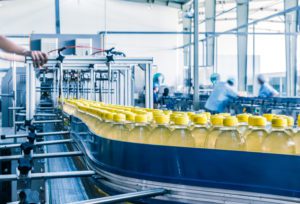Increase Productivity on Your Factory Floor With Manufacturing Technology
Productivity in the Industrial Environment
Productivity is at the very core of manufacturing and industrial operations. Catalyzing it. Extracting even more of it. Much of the productivity conversation in recent years has centered around technology, as plant directors and operations managers realize that manufacturing operations have become increasingly tech-driven. Yet there is also a consensus that the frontline worker on the factory floor remains critical to productivity.
As an operations leader making decisions everyday related to the efficiencies of your plant or region, you need to make sense of technologies and how they can benefit both your plant and your people. A growing and increasingly essential category is connected worker technology.
If you want to learn about the relationship between frontline workers and technology, and how that relationship can be leveraged to drive productivity across your operations, keep reading.
How to Measure Productivity and Impact on the Bottom Line?
Everyone agrees that technology can improve plant productivity, but it’s important to invest in human workers, too. To better understand how these two realities work together, let’s review how productivity is measured.
Certain industries rely on specific benchmarks. For example, consumer packaged goods (CPG) manufacturers look to Overall Equipment Effectiveness (OEE); oil and gas companies rely heavily on a metric known as Non-Productive Time (NPT). As a general rule, inputs versus outputs remain the name of the game – with inputs calculated in terms of people hours relative to labor, equipment hours relative to capital investment, and quality measures relative to materials.
But the game itself has changed, and is changing still as industries and companies face continued uncertainty on multiple fronts.
As with many games, time is a key component. In manufacturing, speed to market can make or break a company. Just-in-time (JIT) manufacturing refers to the workflow processes and methodologies used to reduce flow times within a manufacturing operation. Tech-driven solutions streamline these flows, helping drive productivity. Productivity measurement focuses on overall capabilities, but it really has to do with how efficiently a company’s employees are able to perform their tasks, how quickly a plant’s workers are able to transform a stockpile of raw materials into a resulting yield of goods and services. Efficiency becomes a function of time; it’s about doing more with less.
Yet, there’s one thing that hasn’t changed in industrial manufacturing – the stakes. Today’s hyper competitive global economy has introduced more opportunities, more ways to work and more competition than ever before. As technological advancements continue to transform the industrial sector, opportunity costs are suddenly higher than ever. Worker morale matters more and more.
Most importantly, the impact of lost productivity on the bottom line has never been greater.
Shop Floor Automation and Labor Productivity
You can’t talk about factory automation without talking about the inevitable robot takeovers. And yet, if you’re a manufacturing veteran, you know there’s nothing inevitable about it, that those fears are both highly exaggerated and needlessly worrisome. Full factory automation is not imminent – full stop – especially with research showing that humans still perform 72% of frontline work.
Turns out humans aren’t a cog in the wheel, thanks to our handy powers of cognition, which really can’t be replicated (sorry, Watson).
Automation works best when it’s designed to enhance the abilities of humans. People-centered automation eliminates the tedious or dangerous tasks that humans previously performed; robots and co-bots are a welcomed option particularly for highly repetitive tasks. They’re part of the solution.
But most leaders in the industry agree the whole solution involves investing in humans and machines, or in technologies that benefit both.
Putting easy-to-use, modern digital tools in the hands of today’s industrial frontline workers, making sure they’re easily and quickly connected to the people, information, systems and machines to do their jobs as efficiently, safely and productively as possible – that’s the path forward for a growing number of industrial leaders and their manufacturing operations.
Put another way: Full automation alone won’t remove obstacles to productivity, deploy talent strategically, and encourage frontline and back officer workers alike to perform at the highest level. Robots alone won’t afford workers with faster access to information and easier, more efficient ways to use data and analytics to improve overall performance. The biggest levers affecting productivity (and profits) are still human workers. Companies that empower their workers with digital tools that foster a sharper productivity mindset have a clear advantage.
Increase the Productivity of Your Frontline Workers
Given the very real affinity between frontline workers and technology, it’s more than a little surprising to learn that so few tech companies are committed to capitalizing on it. Plenty of tools and technology have been introduced that improve productivity, but they’re typically designed for people who sit behind a desk. The problem is, 80% of the world’s workforce doesn’t sit behind a desk. That’s roughly 2.7 billion employees.
With a scant 1% of the sum total of all software investment geared toward meeting the needs of deskless workers, it’s safe to say an opportunity has been missed. After all, factory workers need powerful computing platforms, intuitive user interfaces and mobile technology, too. Savvy plant managers understand that equipping their workforce with modern digital tools is critical to improving productivity. With Generation Z entering the workforce in higher numbers every year, and as Millennials take on management positions, they also realize they have no choice.
Connected Worker® by Parsable is the answer.
Manufacturing Technology and Connected Solutions Can Help Increase Productivity
The appeal of connected work is rooted in the fact that frontline workers and factory machines serve different purposes in the manufacturing process. Where machines bring predictability and consistency to production processes, humans provide critical, adaptive decision-making and critical thinking skills. Implemented correctly, technology assists with both; it improves worker output and machine efficiency. This overlap is the essence of connected work.
The highly digitized nature of Connected Worker by Parsable essentially reinvents the way factory work gets done, enabling employees to move beyond siloed communication and guesswork, to predicting outcomes and responding to situations in real time – based on data. Machines benefit from the increased transparency. Workers are empowered by the collaborative process.
Everyone becomes a change agent and productivity catalyst.
Think of it as a human-centered approach to manufacturing. Connected work is the difference between a plant that has digital, interactive work procedures and analyzes data collected from those processes to continuously improve the work, to a factory floor that relies on walkie-talkies, binders stuffed full of outdated paper processes and tribal knowledge.
That’s more than a difference. It’s a difference-maker.
And it’s what industry leaders are talking about
Digital Work Instructions Can Help Increase Productivity on Your Factory Floor
Digitally transforming how industrial teams execute work has foundational implications. It enables factory managers to get the most out of their people and machines. It can affect everything from preventative maintenance, to shift changes, to design for assembly/disassembly (DfAD).
In a digitally empowered environment, workers are able to connect with the people, information, systems and machines to execute work procedures more accurately and efficiently.
Here are three reasons why people-centered, connected worker technology should be on every factory floor.
1) Consistency
Connected worker technology improves consistency of productivity and quality by digitizing standard operating procedures (SOPs), or work instructions, across teams and sites. With digital SOPs, tasks are easier to deploy, and consistency and compliance are tracked.
Consider a shift change, the ritual transfer between workers whose efficiency can make or break a plant’s productivity output. Leveraging connected worker technology helps to ensure shift changeovers and handoffs happen smoothly, ensuring critical information isn’t fumbled or misinterpreted in the exchange.
In today’s highly competitive, highly adaptive manufacturing world, frontline workers need access to up-to-date procedures. Getting rid of paper ensures everyone is on the same page. It’s more than a nice-to-have. It’s the key to consistency, central to scaling and fundamental for continuous improvement.
2) Transparency
Another key benefit of connected worker technology is that it affords operations directors and plant managers greater visibility across their workforce. This is true even if part of that workforce is remote, or involves distributed workers who may not always have easy, timely access to expertise.
Increased visibility enables plant managers and directors, factory floor and back office workers alike to react and adapt to unexpected changes. Changing strategy becomes a lot easier when your team can very quickly identify, say, how shifting to a different production line will reverberate throughout your entire operation, and can make sure your workers have updated digital work instructions at their fingertips.
Not least, greater visibility lends itself to worker empowerment. From the factory floor to the back office and every responsibility in between, everyone becomes a change maker. Whether it involves a modification for a new safety measure, or reacting to a sudden change in product demand, everyone is looking at the same challenge, in the same way, in real time.
And you never know who might provide the solution.
3) Collaboration
Every experienced plant manager knows: When workers collaborate, factories win.
With Connected Worker by Parsable, collaboration becomes easier than ever. Whether it involves guiding a team of workers through a specific task or sharing information between shifts, teams or departments, it gives your workers the tools they need to simplify communication, streamline workflow and get more done together.
The technology’s ease of use will floor your factory (in a good way). The interface is both intuitive and multi-faceted. A worker who logs an equipment reading that indicates a dangerous situation can notify the relevant team members, capture photos or videos to provide context of the situation and receive immediate guidance. The solution is at their fingertips.
When the collaboration is instantaneous, problems can be solved quicker than ever.
Data at the Center of Manufacturing Productivity and Continuous Improvement
Dr. W. Edwards Deming’s philosophy of continuous quality improvement is another aspect of manufacturing life that hasn’t changed much throughout the years. It’s only become more integral.
If factories aren’t finding new ways to drive efficiency, to convert stockpiles of raw materials into finished goods and services more nimbly than ever, it’s only a matter of time before they get left behind.
Real-time, data-driven sustainability is the key, and a connected work environment once more delivers, providing analytics that measure execution and performance. Worker-focused technology captures worker activity data, showing where the roadblocks are in operational processes, and yielding insights for improved performance and safety. Feeding those real-time insights back into work is what Deming’s famous quality improvement process is all about.
Humans + Machines in Industrial Operations
Dr. Deming had it right. Factories of the future will continue to search for new efficiencies they can use to maximize productivity. Their survival depends on it.
Elon Musk had it right, too. “Excessive automation at Tesla was a mistake,” he said, in the aftermath of a failed attempt to deliver the company’s Model 3s using a highly automated production line. “Humans are underrated.”
We’d go one step further and say. Humans are indispensable. “Lights out” may mean a factory can operate without human intervention. It does not mean it will be more efficient or more productive. The greatest opportunity to drive productivity still lies with your people. Connected Worker by Parsable provides the ability to tap into human potential, and to reveal hidden human activity data that allows workers to do their jobs better. It offers insights companies need to start identifying patterns that improve processes and productivity.
Embark on Your Digital Journey
Have we mentioned speed? Time can’t be purchased, but it also can’t be ignored. Every Industry 4.0 initiative claims to make the factory floor ‘smarter.’ The problem with the majority of these initiatives is the time it takes to implement them (often, many years). Rome wasn’t built in a day. Expectations for the digital transformation of the manufacturing world should be similarly tempered. It’s a process flow that can feel more like a trickle.
That’s the bad news. The good news is that, comparatively speaking, a full-functioning connected worker environment can be implemented quicker than you think. This largely has to do with the fact that the required infrastructure – workers, machines – is already in place. “Adding digital” empowers your workers to drive productivity improvements back into their work – no waiting, no falling behind – exactly what the Fourth Industrial Revolution aspires to achieve.
So what are you waiting for? Get started now.







